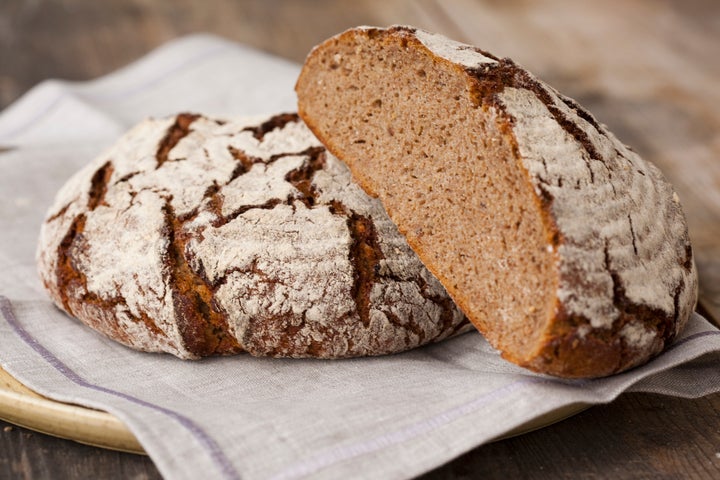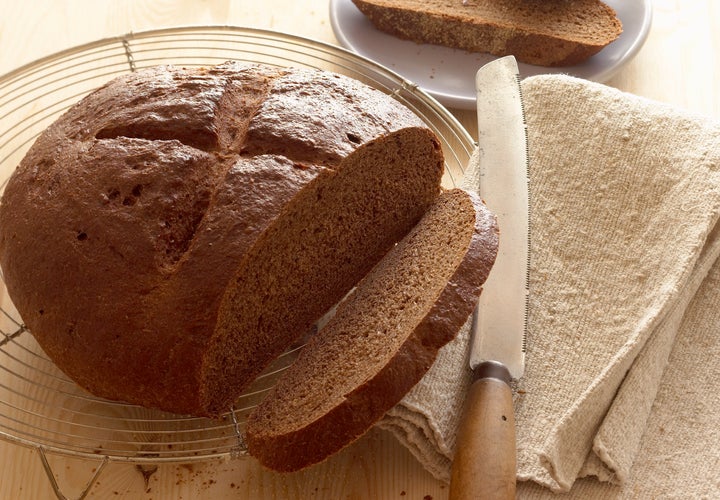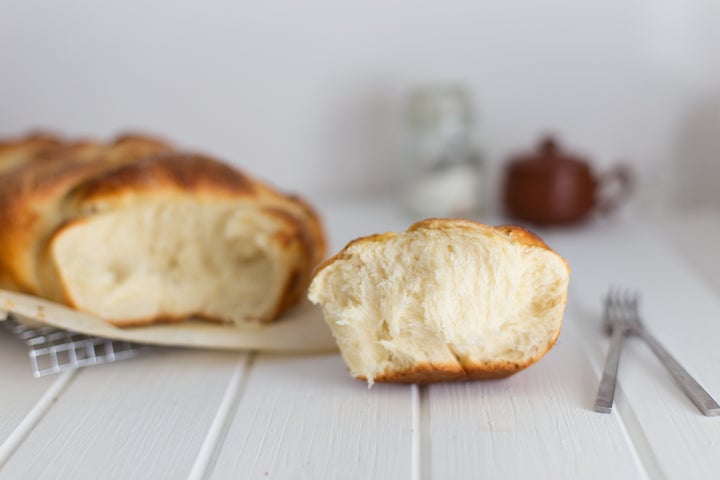No matter how much you love bread, sadly, bread doesn’t always love you back.
With so many different types of bread, it can be confusing as to where some of them fall on the spectrum of health and nutrition. It’s pretty obvious that a lathered-up plain bagel is better for your cheat day, but how about rye or multigrain? And what does whole grain even mean?
We asked five experts to rank 19 popular bread varieties by nutritional merit. There is some disagreement across the board, but averaging the rankings left us with a sliding scale that represents a rough idea of the breads that pack vital nutrients and those that are really just there to test the tensile strength of your waistband.
Within the explanations are some interesting tidbits and tips on purchasing bread. Nutritionist and Candida Diet proponent Lisa Richards, for example, cautioned against buying anything “enriched.”
“This tells you immediately that it has been processed and it’s made from flour that will spike your glucose and create inflammation,” she said.
Other than that, one other big tip is to remember the word “whole.” Keep reading for the rankings.
(Average score listed is on a scale of 1 to 19: For example, a score of 3 could mean one judge ranked the bread No. 1 and another judge ranked it No. 5.)
Tied For No. 1: Whole Grain (3.4)
We have a tie at the top with whole-grain and whole-wheat bread, both of which promise that you’re getting all of the nutrients of the wheat grain as they use the whole kernel: the bran, germ and endosperm.
And there is tremendous value packed into that fact. According to Dr. William Li, author of “Eat to Beat Disease,” research shows whole-grain intake is associated with a lower risk of cardiovascular disease.
Li explained there are other benefits: “Lab studies of nutrients in whole grain can help protect stem cells needed to regenerate our organs, and they can reduce the growth of blood vessels that feed tumors.”
And as for other parts of the body, Li said, “The fiber in whole-grain bread is a prebiotic that feeds our healthy gut bacteria.”
Huzzahs all around.
Tied For No. 1: Whole Wheat (3.4)
Whereas whole-grain bread contains the entire kernel of wheat and other grains (like oats or barley), whole-wheat bread only contains the kernel of wheat.
“Whole wheat is a great option,” explained Brianne Bell, a registered dietitian and operator of the Frugal Minimalist Kitchen. “But it’s good to have a variety of grains.”
Richards reminded us that we should be wary of whole-wheat products that say they’ve been “enriched.” “If this term is there, it is not true 100% whole wheat and has been through a process of removing and adding synthetic vitamins and minerals,” she said.
And because things are never easy, the market further complicates matters by demanding you not just search out whole wheat, but concentrate on the percentage of whole grains in the product.
Amanda A. Kostro Miller, a registered dietitian and board adviser of Smart Healthy Living, explained: “Some regulations allow manufacturers to label their product as ‘whole wheat’ even if it only has 51% whole-wheat flour.” She advised you look for bread that boasts being 100% whole wheat.
No. 3: Sprouted Grain (Ezekiel) (4)
One of the healthiest breads to throw into your grocery cart is also a bit of an acquired taste, according to registered dietitian, nutritionist and certified diabetes educator Jana Mowrer.
If you do happen to like bread such as Ezekiel, you’re going to also enjoy a variety that boasts “lower sodium, higher protein and more fiber than most other breads on the market,” Mowrer told HuffPost.
Essentially what you’re getting is bread made with grain that was allowed to sprout prior to grinding. The outcome is quite nutritious, according to Bell. “The sprouting process changes the nutrient profile of the grain by unlocking some amino acids that weren’t accessible before. This creates a higher-protein bread,” she said.

No. 4: Sourdough (4.2)
There is perhaps no more delectable bread than the fermented kind that, when done correctly, has the perfect crust and chew of sourdough.
And because it’s fermented, it’s actually very good for your gastrointestinal health.
“Researchers at MIT have shown that Lactobacillus reuteri (found in fermentation) can stimulate and boost the immune system, reduce the development of breast and colon tumors, speed up healing of skin wounds, and even stimulate the brain to release the social hormone oxytocin,” Li explained.
And that’s just your regular sourdough. If you search out whole grain, you’re getting a super bread that not only tastes great but is great for you.
“If the traditional sourdough method is used and it’s made with whole grains, sourdough bread provides the nutrition of whole grains plus the benefits of fermentation, which lowers the bread pH,” Mowrer said. “This means more vitamins and minerals are absorbed. Plus, it has a lower glycemic index, so there is less of a blood sugar spike.”
No. 5: Rye (5.4)
Rye has a great deal in common with the aforementioned varieties. It’s good for gut health and is said to have a slow digestion transit time, which means you will feel full longer.
Richards broke down the specifics of rye: “Rye bread is made from a cereal grain that is difficult to separate the germ and bran from the endosperm. This means it is refined, but retains a lot of its nutrients, unlike refined wheat bread and other refined breads.”
No. 6: Multigrain (6)
And now we come to another confounding bread variety, the seemingly ubiquitous multigrain.
“Multigrain means there is more than one grain used,” Bell said, but “it doesn’t mean the nutritious parts of the whole grain are used.”
If you want it to maximize nutrition, be on the lookout for either 100% multigrain or, as Mowrer recommended, “Make sure whole grain flour is the first ingredient on the label.” Then you’re getting something that comes with a lot of fiber, is low fat and has “various vitamins such as Vitamin B6, iron and magnesium.”
No. 7: Whole-Wheat Pita (6.8)
You have to love any flatbread designed to dip, grab or just lie there as you pile on mounds of shawarma. And a pita by itself can be rather healthy, with some caveats.
As you may have realized by now, we are looking for whole grain wherever we can find it. And a pita packing the entire grain is similar to whole-wheat bread.
However, there are things you have to look out for. “One thing to keep in mind is that some pita bread is higher in calories than a regular slice of bread, so consider cutting each pita in half,” said Kostro Miller.
No. 8: Corn Tortilla (7.8)
Let’s be honest, a corn tortilla’s destiny is to team up with pals like al pastor, carnitas or carne asada. When you add such flavorful and, oftentimes, fatty meats, it’s good to know that there are some nutritional benefits wrapped around that chargrilled goodness.
“While corn tortillas don’t offer much in the way of vitamins and minerals, they’re ranking high on the list because of their gluten-free nature,” Richards said. “This provides those with celiac disease or [those] who choose to remove gluten from their diet for health reasons a great source of carbs without inflammatory gluten.”
And if you’re looking to power your week with a smart carb choice, Mowrer liked this option. “It’s a low-fat option with higher levels of potassium, great for those looking to follow a heart-healthy or diabetic-friendly diet, while still enjoying Taco Tuesday.”

No. 9: Pumpernickel (8)
Much like rye, pumpernickel also uses a sourdough starter but uses the entire rye berry.
“Rye contains dietary fiber and natural bioactive chemicals that can benefit the microbiome,” Li explained. “Researchers have found that eating rye can lower the number of harmful gut bacteria that cause inflammation.”
So, pumpernickel is one bread to consider if you are also looking to add anti-inflammatory properties to your daily intake.
It also has a low glycemic load, so it’s easy on the blood sugar, according to Richards. And it “contains a compound known as lignans that are said to prevent prostate and breast cancers,” she said.
No. 10: Wheat (9)
Wheat bread is dangerously close to marketing itself simply as “bread.” It promises that it has been made with wheat flour but then kind of stops abruptly after that, and hopes you do too.
Bell advised to essentially “treat it the same as white bread.”
Richards echoed that sentiment. “Simple wheat bread tricks many into thinking it is equal to 100% whole wheat, but this is not the case,” she said. ”To put it simply, this type of bread is the same as white bread, just unbleached.”
No. 11: Baguette (11)
Bell explained that a white baguette has similar nutrition to your average white bread, with one important distinction, as it will have “more simple ingredients and shorter shelf life than typical white sandwich bread, which is a sign that it has fewer preservatives.”
To be traditional French bread, it must be made without additional fat. But while it’s low in fat, it’s also lower in protein and higher in sodium levels, according to Mowrer.
No. 12: Potato Bread (11.2)
As its name suggests, potato makes its way into the recipe, producing a bread that is on par with white bread as far as taste and texture.
There is some conjecture as to whether this is gluten-free fare. Check the labels accordingly, because wheat gluten is often used to make it.
It also has “a limited overall nutritional contribution from a micronutrient perspective,” according to Mowrer, who said you don’t have to kick this bread out of the kitchen. However, she would “limit to 50% of intake with other whole-grain/sprouted-grain breads.”
No. 13: Ciabatta (12.6)
If the top of the list represents all of the bread you should consider nutritionally, the rest of this list represents the losers.
“Ciabatta bread is relatively high in carbohydrates and has nearly zero grams of fiber,” Richards cautioned.
Mowrer added some other red flags, which include “higher carbs, calories and sodium per slice compared to other bread.”
No. 14: White Italian (13.6)
Mowrer explained that this bread is typically lower in fiber as well as lower in iron and protein. At this point, you really should be shopping for taste and texture, because you aren’t getting nearly as much nutritional value as with other bread.
“This type of bread is not much different nutritionally from white sandwich bread,” Richards said. “It is generally softer on the inside with a light crust on the outside that typically attracts consumers.”

No. 15: Brioche (14)
Take bread, super-size it with the good stuff (butter and eggs) and you get brioche, a bread that is just screaming to be toasted, dunked in even more egg and fried on the griddle in even more butter.
“Keep in mind that these buns can sometimes have a lot of calories, so you may want to consider doing an open-faced sandwich,” Kostro Miller warned.
“Brioche contains a high amount of carbs and fat, making it a less than ideal bread,” Richards cautioned. “The carbs are from refined flour which means it will spike blood glucose as well as cause inflammation.”
This is your celebratory brunch or barbecue bread, not the kind that you should incorporate into your daily sandwich-making.
No. 16: White Pita (14.6)
Much like white bread, white pita is generally drained of all the good nutrition.
It does share some attributes with its brother, though. “Similarly to the whole-grain pita, however, these can have more calories than a slice of bread, so think about splitting it in half,” Kostro Miller said.
“The white pita is a lot like plain white sandwich bread nutritionally,” Richards noted. “It can be easy to assume they are healthy because of the Mediterranean-type foods they are usually paired with. However, this is not necessarily the case.”
No. 17: Flour Tortilla (15.8)
As you likely already guessed, flour tortilla’s irresistibility is commensurate with plenty of health risks.
“Check the ingredients,” Bell said. “If they’re just wheat flour, water, oil and salt like traditional tortillas, they’re fine. But most of the packaged ones have a lot of preservatives and texture modifiers that are only there for the product shelf life, and not adding nutrition.”
If that weren’t enough, Richards pointed out that “unlike the corn tortilla, the flour tortilla gets moved closer to the bottom of the list because it offers the same low nutritional value, but also gluten which can wreak havoc on your gut and overall health.”
No. 18: White Sandwich Bread (17)
According to Bell, this staple of so many childhood lunches is “generally low in fiber and flavor and has a lot of preservatives and other ingredients that are only used for shelf life and texture of the bread but don’t add any nutrition.”
Richards battered away on our beloved bologna sandwich accouterment of choice.
“This bread is at the bottom of the list because it really offers little in the way of vitamins and minerals,” she said. “White sandwich bread is made with flour that has had the bran and germ removed leaving the white endosperm, which is the portion of the kernel that is primarily starch.”
No. 19: Bagels (17.6)
The only thing that you ever need to know about this breakfast delicacy is that it’s best enjoyed in extreme moderation. It’s dense, and the experts all agreed on one fact that will have you reconsidering your breakfast choices: Bagels are so dense that eating one is like eating four slices of regular bread. And if you have ever sat down to eat four slices of bread, you know that doing so should lead to immediate soul-searching.